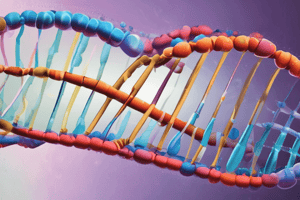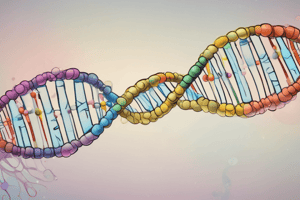Podcast
Questions and Answers
What is the consequence of a deletion in a gene's coding sequence that removes the start signal?
What is the consequence of a deletion in a gene's coding sequence that removes the start signal?
- The gene may produce multiple copies of itself.
- The gene may produce a non-functional protein. (correct)
- The gene may produce an excess of functional proteins.
- The gene may replicate faster.
Which type of chromosomal mutation involves the breaking of one chromosome and the rearrangement of the genetic material?
Which type of chromosomal mutation involves the breaking of one chromosome and the rearrangement of the genetic material?
- Deletion
- Duplication
- Inversion (correct)
- Translocation
What is the result of chromosomal translocation?
What is the result of chromosomal translocation?
- A section of a chromosome is inverted.
- A section of one chromosome is deleted.
- A section of one chromosome becomes attached to a different chromosome. (correct)
- A section of a chromosome replicates.
Which syndrome is associated with a deletion of a part of chromosome 5?
Which syndrome is associated with a deletion of a part of chromosome 5?
Which type of mutation involves a gene or region of a chromosome appearing two or more times in a row?
Which type of mutation involves a gene or region of a chromosome appearing two or more times in a row?
What is the primary structure of DNA as concluded by Rosalind Franklin?
What is the primary structure of DNA as concluded by Rosalind Franklin?
Which components of DNA are found on the outside of the helical structure?
Which components of DNA are found on the outside of the helical structure?
What distinguishes RNA from DNA?
What distinguishes RNA from DNA?
What is the role of helicase in DNA replication?
What is the role of helicase in DNA replication?
During DNA replication, what does the semi-conservative model imply?
During DNA replication, what does the semi-conservative model imply?
What are the 'rungs' of the twisted ladder structure of DNA formed by?
What are the 'rungs' of the twisted ladder structure of DNA formed by?
Which nucleotide sequence represents the starting point of DNA replication?
Which nucleotide sequence represents the starting point of DNA replication?
What is the purpose of proofreading during DNA replication?
What is the purpose of proofreading during DNA replication?
What direction does elongation occur in during DNA replication?
What direction does elongation occur in during DNA replication?
Which enzyme is responsible for proofreading base pairing during DNA replication?
Which enzyme is responsible for proofreading base pairing during DNA replication?
What term describes the segments of the lagging strand during DNA replication?
What term describes the segments of the lagging strand during DNA replication?
What type of mutation results from the deletion of one or more nucleotides that impacts the reading frame?
What type of mutation results from the deletion of one or more nucleotides that impacts the reading frame?
What is the role of DNA ligase during DNA replication?
What is the role of DNA ligase during DNA replication?
Which strand is continuously replicated during DNA replication?
Which strand is continuously replicated during DNA replication?
What is the primary function of transfer RNA (tRNA) during translation?
What is the primary function of transfer RNA (tRNA) during translation?
What codon initiates protein synthesis?
What codon initiates protein synthesis?
Which statement accurately describes a silent mutation?
Which statement accurately describes a silent mutation?
What is the first step in the process of protein synthesis?
What is the first step in the process of protein synthesis?
Which nucleotide base is present in RNA but not in DNA?
Which nucleotide base is present in RNA but not in DNA?
What type of mutation could potentially cause a genetic disorder, such as sickle cell disease?
What type of mutation could potentially cause a genetic disorder, such as sickle cell disease?
Which base pairs with Adenine (A) in RNA?
Which base pairs with Adenine (A) in RNA?
Which of the following correctly defines a point mutation?
Which of the following correctly defines a point mutation?
Flashcards
Replication
Replication
The process of copying DNA.
Gene
Gene
A functional sub-unit of DNA that directs the production of one or more polypeptides (protein molecules).
Genome
Genome
The total DNA in an organism's cells.
Chromosome
Chromosome
Signup and view all the flashcards
Helicase
Helicase
Signup and view all the flashcards
Semi-conservative Model
Semi-conservative Model
Signup and view all the flashcards
Replication Origin
Replication Origin
Signup and view all the flashcards
Replication Bubble
Replication Bubble
Signup and view all the flashcards
Chromosomal Mutations
Chromosomal Mutations
Signup and view all the flashcards
Chromosomal Deletion
Chromosomal Deletion
Signup and view all the flashcards
Chromosome Duplication
Chromosome Duplication
Signup and view all the flashcards
Chromosome Inversion
Chromosome Inversion
Signup and view all the flashcards
Translocation
Translocation
Signup and view all the flashcards
Replication Fork
Replication Fork
Signup and view all the flashcards
DNA Elongation
DNA Elongation
Signup and view all the flashcards
DNA Polymerase
DNA Polymerase
Signup and view all the flashcards
RNA Primer
RNA Primer
Signup and view all the flashcards
Leading Strand
Leading Strand
Signup and view all the flashcards
Lagging Strand
Lagging Strand
Signup and view all the flashcards
Okazaki Fragments
Okazaki Fragments
Signup and view all the flashcards
DNA Ligase
DNA Ligase
Signup and view all the flashcards
DNA Replication Termination
DNA Replication Termination
Signup and view all the flashcards
Transcription
Transcription
Signup and view all the flashcards
Messenger RNA (mRNA)
Messenger RNA (mRNA)
Signup and view all the flashcards
RNA Polymerase
RNA Polymerase
Signup and view all the flashcards
Codon
Codon
Signup and view all the flashcards
Transfer RNA (tRNA)
Transfer RNA (tRNA)
Signup and view all the flashcards
Study Notes
DNA Structure and Replication
- DNA is a double helix, resembling a twisted ladder
- Sugar-phosphate backbones form the "handrails"
- Nitrogenous bases (A, T, G, C) form the "rungs"
- Strands are antiparallel (5' to 3' and 3' to 5')
- DNA is a thread-like molecule composed of two long strands of nucleotides
- RNA is similar to DNA but contains ribose sugar, uracil instead of thymine, and is single-stranded
- DNA replication follows a semi-conservative model; each new DNA molecule contains one original strand and one new strand.
Four Stages of DNA Replication
- Initiation: Replication begins at a specific site (replication origin)
- Elongation: New nucleotides are added to the 3' end of the existing strand.
- Termination: Replication is completed
- Proofreading: DNA polymerase corrects errors
Enzymes Involved in DNA Replication
- Helicase: Unwinds the DNA double helix
- DNA Polymerase: Adds nucleotides and proofreads
- Primase: Creates RNA primers for nucleotide addition
- DNA Ligase: Joins Okazaki fragments on the lagging strand
Leading and Lagging Strands
- Leading strand: Synthesized continuously in the 5' to 3' direction
- Lagging strand: Synthesized in short segments (Okazaki fragments) in the 5' to 3' direction.
Transcription and Translation
- Transcription: DNA information is copied into mRNA
- Translation: mRNA sequence is used to produce a polypeptide (protein)
- Messenger RNA (mRNA): Carries genetic code from DNA to ribosomes
- Transfer RNA (tRNA): Delivers amino acids to ribosomes during translation
- Ribosomal RNA (rRNA): Forms part of ribosomes
Genetic Code and Mutations
- Codons (3-base sequences) code for specific amino acids
- Point mutations: Changes in single nucleotides
- Silent mutations: No change in amino acid sequence
- Missense mutations: Change to a different amino acid
- Nonsense mutations: Premature stop codon, resulting in truncated protein
- Frameshift mutations: Insertion or deletion altering the reading frame.
Protein Synthesis
- Two main steps: transcription & translation
- mRNA carries code to cytoplasm from DNA
- tRNA brings amino acids, matching mRNA codons
- Ribosome assembles polypeptide chain
- Amino acid sequence determines protein structure and function.
Types of Mutations
- Substitution, Insertion, Deletion of nucleotides
- Frameshift mutations
- Silent mutations : No effect on protein result
- Mis-sense mutations: Alter amino acid sequence; could be harmful or neutral
- Non-sense mutations; premature stop; harmfull
- Chromosomal Mutations: Rearrangements involving multiple genes or chromosomes.
- Duplication, Inversion, Deletion, Insertion, Translocation
Studying That Suits You
Use AI to generate personalized quizzes and flashcards to suit your learning preferences.




